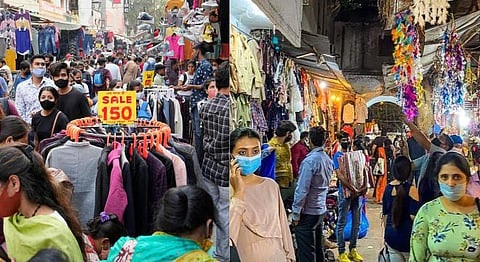
- HOMEGROWN WORLD
- #HGCREATORS
- #HGEXPLORE
- #HGVOICES
- #HGSHOP
- CAREERS
- ABOUT US
- CONTACT US

A hike in consumerism tied with soaring rates of clothes has started to push people towards thrifting instead of going to malls. In the west, there are usually designated and independent thrift stories, but people resort to markets with affordable shopping options in India. One of the most famous and subsequently the most visited market is the Sarojini Nagar Market. If you live in Delhi, you are not a stranger to this retail destination. With endless shops or sellers who carry their products with them in an attempt to market and sell to shoppers as they walk around, Sarojini Nagar never sleeps.
Fashion At An Affordable Price
Its most advantageous selling points are the affordable prices, the diversity in options and clothes that are not too far off in terms of style with brands like H&M, Zara or FabIndia. Sarojini Nagar attracts a highly diverse and colossal crowd, resulting in sufficient profit-making for each vendor despite the infinite amounts of haggling. However, as much as people love to visit Sarojini, most are often bewildered about how satisfactory pieces of clothing are sold at such low prices.
The mechanism of the market is quite simple. Most of the clothes you pick up at the market are export surplus. This means that the factories contracted to make clothes by global companies like Zara or H&M always make 3% more of what is required. They do this because many pieces get chucked during quality inspection for minuscule mistakes like colour mismatch or stitch inaccuracy. Vendors at Sarojini acquire these clothes in bulk at prices lower than what they sell us at and make an average of 20% profit on each sale.
The People of Sarojini
The vendors and sellers of Sarojini are regular businessmen that are used to adapting to their customers and the situation’s wants and needs. Some of the shopkeepers that sell here have been a part of the market since it got transformed from an open market for groceries and electronics to a fashion hub post-1990 LPG reforms in India. Some are newer entrepreneurs who set up shop to take advantage of the number of people that turn up at the market every day.
It does have to be said that the vendors at Sarojini live on the edge. Since the government disallowed setting up shop on the streets of the market, you find the shopkeepers running and hurrying to clear the racks of clothes they set up outside their shops when police officers come by for an inspection. As a shopper standing in the street as the process unfolds, it feels nothing less than a Bollywood action movie, with sellers trying their best to avoid getting fined.
A Consumerist and Economic Dilemma
A consumerist paradise and a haven for fashion on a budget, Sarojini or similar local markets in other cities still assume the top position in the hierarchy of thrifting. It is also crucial to acknowledge that the term thrifting originates from privileged vocabulary and only finds validity in the rich men’s worlds. For years, Sarojini and other local markets have stood out as the only option for buying clothes for the lesser economically privileged individuals. For them, it isn’t thrifting but plain bi-monthly shopping.
The hike in the popularity of the Sarojini Market also poses a growing consumerism issue. It is evident that the presence of countless options at affordable prices allows individuals to shop more. The more clothes we buy translates to the more clothes we throw out eventually, and that translates to more waste we cannot process environmentally. The functioning of these markets then poses a dilemma which has economic, social and ecological aspects. It pushes us to prioritise between two things that, on a level, cannot be compared or preferred over the other. The absence of markets like Sarojini will pose a diabolical problem of affordability for individuals who can only afford these markets’ prices. However, the growth of such retailers adds to the suffering of the environment and pushes consumerism to feed the capitalist dream.
While we must dissect how fashion isn’t exclusive to contemporary socio-economic and environmental issues, it is also truly an experience to visit Sarojini. So, take the pink line, get down at Sarojini Nagar and try your hand at haggling for a ₹300 top. It’s good for your health.
If you enjoyed reading this, we suggest you also read:
